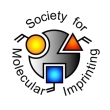
Authors: Azimi A, Javanbakht M
Article Title: Computational prediction and experimental selectivity coefficients for hydroxyzine and cetirizine molecularly imprinted polymer based potentiometric sensors.
Publication date: 2014
Journal: Analytica Chimica Acta
Volume: 812
Page numbers: 184-190.
DOI: 10.1016/j.aca.2013.12.042
Alternative URL: http://www.sciencedirect.com/science/article/pii/S0003267014000294
Abstract: In spite of the increasing usages number of molecularly imprinted polymers (MIPs) in many scientific applications, the theoretical aspects of participating intra molecular forces are not fully understood. This work investigates effects of the electrostatic force, the Mulliken charge and the role of cavity's backbone atoms on the selectivity of MIPs. Moreover, charge distribution, which is a computational parameter, was proposed for the prediction of the selectivity coefficients of MIP-based sensors. In the computational approaches and experimental study, methacrylic acid (MAA) was chosen as the functional monomer and ethylene glycol dimethacrylate (EGDMA) as the cross linker for hydroxyzine and cetirizine imprinted polymers. Ab initio, DFT B3LYP method was carried out on molecular optimization. With regard to results obtained from molecules optimization and hydrogen bonding properties, possible configurations of 1:n (n Gëñ 5) template/monomer complexes were designed and optimized. The binding energy for each complex in gas phase was calculated. Depending on the most stable configuration, hydroxyzine and cetirizine imprinted polymer models were designed. The calculations including the porogen were also investigated. The theoretical charge distributions for the template and some potential interfering molecules were calculated. The results showed a correlation between the selectivity coefficients and the theoretical charge distributions. The results surprisingly show that charge distribution based model was able to predict the selectivity coefficients of MIP based potentiometric sensors
Template and target information: cetirizine, hydroxyzine
Author keywords: imprinted polymer, computational approach, Charge distribution, selectivity, potentiometric sensor



Join the Society for Molecular Imprinting

New items RSS feed
Sign-up for e-mail updates:
Choose between receiving an occasional newsletter or more frequent e-mail alerts.
Click here to go to the sign-up page.
Is your name elemental or peptidic? Enter your name and find out by clicking either of the buttons below!
Other products you may like:
 MIPdatabase
MIPdatabase









